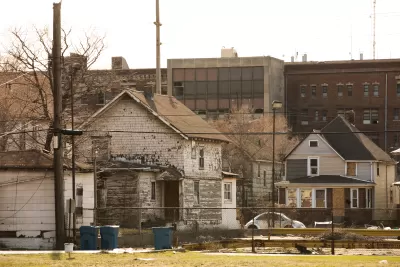As more evidence shows that neighborhood-level factors heavily impact future outcomes, place-based policies should use more accurate measurements to ensure persistently poor places don’t fall through the cracks.

A commentary in Route Fifty by August Benzow and Kenan Fikri describes how new research explains “how an economically distressed place can transmit poverty from one generation to the next.”
For the authors; it is important to point out that “Pioneering researchers like Harvard’s Raj Chetty have shown that children who grow up in high-poverty environments are less likely to climb the income ladder as adults,” contrary to the popular American narrative of bootstrap success.
For Benzow and Fikri, “the way we measure and target persistent poverty leaves millions of vulnerable Americans invisible to programs intended to support them.” This includes how places are designated as ‘chronically poor,’ which is currently done at the county level. “Looking no deeper severely underestimates the size of the problem and therefore the scope of the challenge. Roughly 20.5 million Americans live in a persistent-poverty county, but 35 million reside in a persistent-poverty census tract.”
The article concludes that “high poverty rates will persist across thousands of American communities because the fabric that weaves them into the national economy has grown threadbare.” The authors call for “a growth agenda for persistent-poverty communities—the very places where the nation’s social and economic challenges are greatest.”
FULL STORY: Will the new wave of place-based policy leave persistently poor areas behind?

Planetizen Federal Action Tracker
A weekly monitor of how Trump’s orders and actions are impacting planners and planning in America.

Congressman Proposes Bill to Rename DC Metro “Trump Train”
The Make Autorail Great Again Act would withhold federal funding to the system until the Washington Metropolitan Area Transit Authority (WMATA), rebrands as the Washington Metropolitan Authority for Greater Access (WMAGA).

The Simple Legislative Tool Transforming Vacant Downtowns
In California, Michigan and Georgia, an easy win is bringing dollars — and delight — back to city centers.

The States Losing Rural Delivery Rooms at an Alarming Pace
In some states, as few as 9% of rural hospitals still deliver babies. As a result, rising pre-term births, no adequate pre-term care and "harrowing" close calls are a growing reality.

The Small South Asian Republic Going all in on EVs
Thanks to one simple policy change less than five years ago, 65% of new cars in this Himalayan country are now electric.

DC Backpedals on Bike Lane Protection, Swaps Barriers for Paint
Citing aesthetic concerns, the city is removing the concrete barriers and flexposts that once separated Arizona Avenue cyclists from motor vehicles.
Urban Design for Planners 1: Software Tools
This six-course series explores essential urban design concepts using open source software and equips planners with the tools they need to participate fully in the urban design process.
Planning for Universal Design
Learn the tools for implementing Universal Design in planning regulations.
Smith Gee Studio
City of Charlotte
City of Camden Redevelopment Agency
City of Astoria
Transportation Research & Education Center (TREC) at Portland State University
US High Speed Rail Association
City of Camden Redevelopment Agency
Municipality of Princeton (NJ)





























